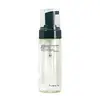What's inside
What's inside
 Key Ingredients
Key Ingredients

 Benefits
Benefits

 Concerns
Concerns

 Ingredients Side-by-side
Ingredients Side-by-side

Water
Skin ConditioningDipropylene Glycol
HumectantDisodium Laureth Sulfosuccinate
CleansingDisodium Cocoyl Glutamate
CleansingCoco-Glucoside
CleansingPolyglyceryl-10 Myristate
Skin ConditioningCamellia Japonica Flower Extract
EmollientCentella Asiatica Extract
CleansingSodium Hyaluronate
HumectantLonicera Japonica Flower Extract
Skin ConditioningMelaleuca Alternifolia Leaf Extract
PerfumingSalvia Officinalis Leaf Extract
CleansingCaprylic/Capric Triglyceride
MaskingCetyl Ethylhexanoate
EmollientEthylhexyl Palmitate
EmollientHydrolyzed Hyaluronic Acid
HumectantHydroxypropyltrimonium Hyaluronate
Sodium Hyaluronate Crosspolymer
HumectantSodium Acetylated Hyaluronate
HumectantMadecassoside
AntioxidantMadecassic Acid
Skin ConditioningAsiaticoside
AntioxidantAsiatic Acid
Skin ConditioningButylene Glycol
HumectantCitric Acid
BufferingCaprylyl Glycol
EmollientHydroxyacetophenone
AntioxidantPentylene Glycol
Skin ConditioningSalix Alba Bark Extract
AstringentPolyquaternium-67
Propanediol
SolventEthylhexylglycerin
Skin ConditioningDisodium EDTA
1,2-Hexanediol
Skin ConditioningWater, Dipropylene Glycol, Disodium Laureth Sulfosuccinate, Disodium Cocoyl Glutamate, Coco-Glucoside, Polyglyceryl-10 Myristate, Camellia Japonica Flower Extract, Centella Asiatica Extract, Sodium Hyaluronate, Lonicera Japonica Flower Extract, Melaleuca Alternifolia Leaf Extract, Salvia Officinalis Leaf Extract, Caprylic/Capric Triglyceride, Cetyl Ethylhexanoate, Ethylhexyl Palmitate, Hydrolyzed Hyaluronic Acid, Hydroxypropyltrimonium Hyaluronate, Sodium Hyaluronate Crosspolymer, Sodium Acetylated Hyaluronate, Madecassoside, Madecassic Acid, Asiaticoside, Asiatic Acid, Butylene Glycol, Citric Acid, Caprylyl Glycol, Hydroxyacetophenone, Pentylene Glycol, Salix Alba Bark Extract, Polyquaternium-67, Propanediol, Ethylhexylglycerin, Disodium EDTA, 1,2-Hexanediol
Betula Platyphylla Japonica Juice
Skin ConditioningGlycerin
HumectantCoco-Betaine
CleansingPotassium Cocoyl Glycinate
Disodium Cocoamphodiacetate
CleansingSucrose
HumectantSodium Chloride
MaskingCitrus Aurantium Bergamia Fruit Oil
MaskingQuillaja Saponaria Bark
CleansingCamellia Sinensis Leaf
PerfumingMoringa Oleifera Seed Extract
Skin ConditioningXylitol
HumectantLactobacillus Ferment
Skin ConditioningLactococcus Ferment Lysate
Skin ConditioningPlankton Extract
Skin ConditioningAsparagus Officinalis Stem Extract
Skin ConditioningBifida Ferment Lysate
Skin ConditioningSalvia Officinalis Leaf
MaskingStreptococcus Thermophilus Ferment
HumectantCoco-Glucoside
CleansingAspartic Acid
MaskingGlyceryl Oleate
EmollientPEG-7 Glyceryl Cocoate
EmulsifyingGlyceryl Caprylate
EmollientCaprylyl Glycol
EmollientSodium Cocoyl Isethionate
Cleansing1,2-Hexanediol
Skin ConditioningMaltodextrin
AbsorbentButylene Glycol
HumectantXylitylglucoside
HumectantAnhydroxylitol
HumectantPropanediol
SolventCaprylic/Capric Triglyceride
MaskingPhospholipids
Skin ConditioningCeramide NP
Skin ConditioningCalcium Carbonate
AbrasiveCopper Gluconate
Skin ConditioningCholesterol
EmollientGluconolactone
Skin ConditioningEthylhexylglycerin
Skin ConditioningArginine
MaskingPhytosterols
Skin ConditioningDisodium EDTA
Phenoxyethanol
PreservativePotassium Sorbate
PreservativeSodium Benzoate
MaskingBetula Platyphylla Japonica Juice, Glycerin, Coco-Betaine, Potassium Cocoyl Glycinate, Disodium Cocoamphodiacetate, Sucrose, Sodium Chloride, Citrus Aurantium Bergamia Fruit Oil, Quillaja Saponaria Bark, Camellia Sinensis Leaf, Moringa Oleifera Seed Extract, Xylitol, Lactobacillus Ferment, Lactococcus Ferment Lysate, Plankton Extract, Asparagus Officinalis Stem Extract, Bifida Ferment Lysate, Salvia Officinalis Leaf, Streptococcus Thermophilus Ferment, Coco-Glucoside, Aspartic Acid, Glyceryl Oleate, PEG-7 Glyceryl Cocoate, Glyceryl Caprylate, Caprylyl Glycol, Sodium Cocoyl Isethionate, 1,2-Hexanediol, Maltodextrin, Butylene Glycol, Xylitylglucoside, Anhydroxylitol, Propanediol, Caprylic/Capric Triglyceride, Phospholipids, Ceramide NP, Calcium Carbonate, Copper Gluconate, Cholesterol, Gluconolactone, Ethylhexylglycerin, Arginine, Phytosterols, Disodium EDTA, Phenoxyethanol, Potassium Sorbate, Sodium Benzoate
 Reviews
Reviews

Ingredients Explained
These ingredients are found in both products.
Ingredients higher up in an ingredient list are typically present in a larger amount.
1,2-Hexanediol is a synthetic liquid and another multi-functional powerhouse.
It is a:
- Humectant, drawing moisture into the skin
- Emollient, helping to soften skin
- Solvent, dispersing and stabilizing formulas
- Preservative booster, enhancing the antimicrobial activity of other preservatives
Butylene Glycol (or BG) is used within cosmetic products for a few different reasons:
Overall, Butylene Glycol is a safe and well-rounded ingredient that works well with other ingredients.
Though this ingredient works well with most skin types, some people with sensitive skin may experience a reaction such as allergic rashes, closed comedones, or itchiness.
Learn more about Butylene GlycolThis ingredient is an emollient, solvent, and texture enhancer. It is considered a skin-softener by helping the skin prevent moisture loss.
It helps thicken a product's formula and makes it easier to spread by dissolving clumping compounds.
Caprylic Triglyceride is made by combining glycerin with coconut oil, forming a clear liquid.
While there is an assumption Caprylic Triglyceride can clog pores due to it being derived from coconut oil, there is no research supporting this.
Learn more about Caprylic/Capric TriglycerideCaprylyl Glycol is a humectant and emollient, meaning it attracts and preserves moisture.
It is a common ingredient in many products, especially those designed to hydrate skin. The primary benefits are retaining moisture, skin softening, and promoting a healthy skin barrier.
Though Caprylyl Glycol is an alcohol derived from fatty acids, it is not the kind that can dry out skin.
This ingredient is also used as a preservative to extend the life of products. It has slight antimicrobial properties.
Learn more about Caprylyl GlycolCoco-Glucoside is a surfactant, or a cleansing ingredient. It is made from glucose and coconut oil.
Surfactants help gather dirt, oil, and other pollutants from your skin to be rinsed away.
This ingredient is considered gentle and non-comedogenic. However, it may still be irritating for some.
Learn more about Coco-GlucosideDisodium EDTA plays a role in making products more stable by aiding other preservatives.
It is a chelating agent, meaning it neutralizes metal ions that may be found in a product.
Disodium EDTA is a salt of edetic acid and is found to be safe in cosmetic ingredients.
Learn more about Disodium EDTAEthylhexylglycerin (we can't pronounce this either) is commonly used as a preservative and skin softener. It is derived from glyceryl.
You might see Ethylhexylglycerin often paired with other preservatives such as phenoxyethanol. Ethylhexylglycerin has been found to increase the effectiveness of these other preservatives.
Propanediol is an all-star ingredient. It softens, hydrates, and smooths the skin.
It’s often used to:
Propanediol is not likely to cause sensitivity and considered safe to use. It is derived from corn or petroleum with a clear color and no scent.
Learn more about Propanediol